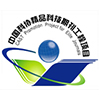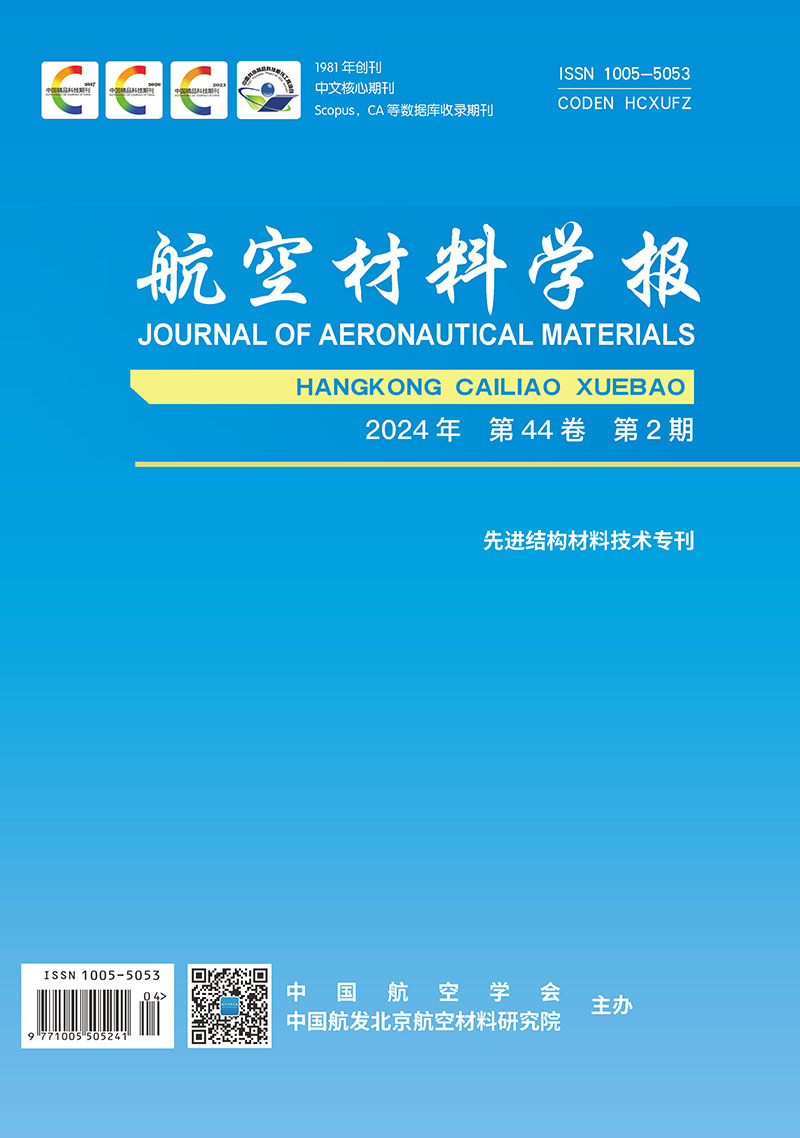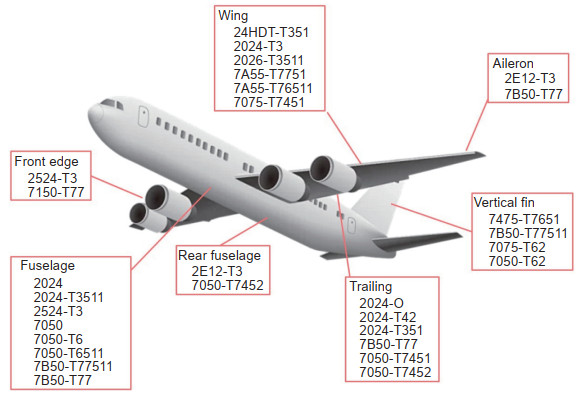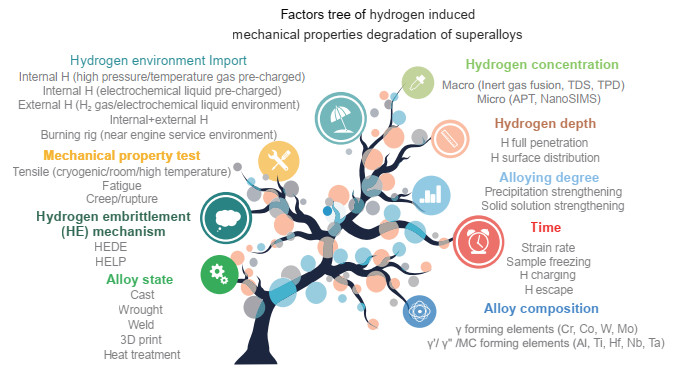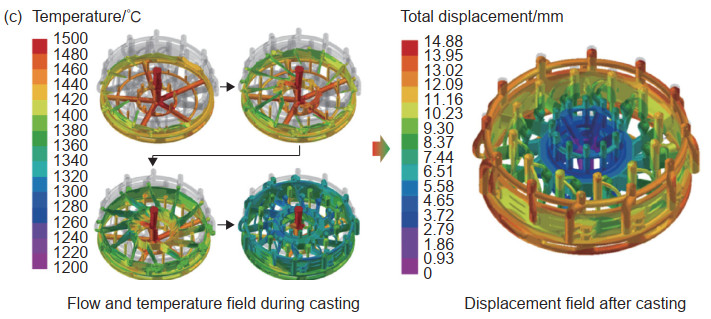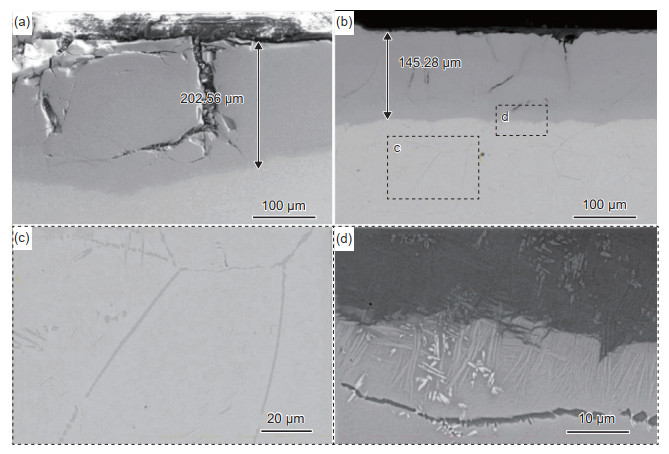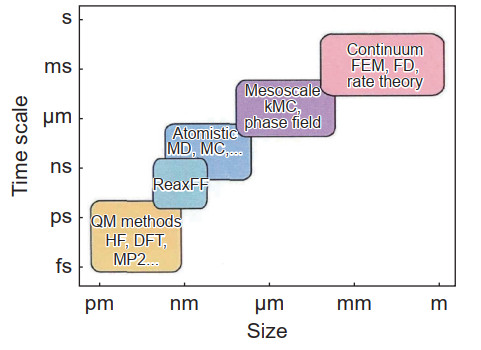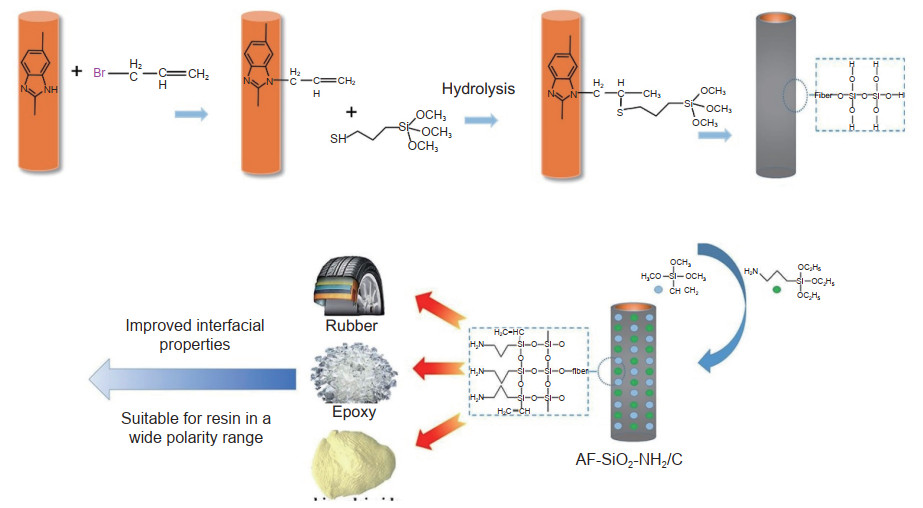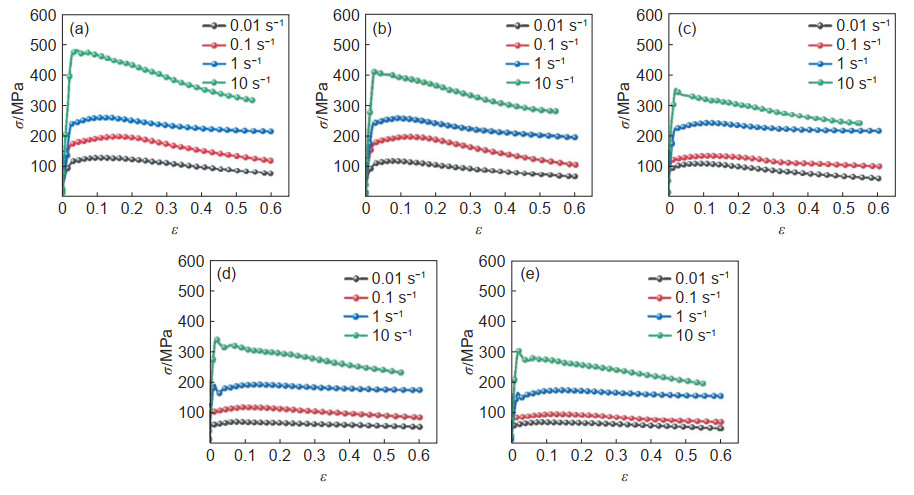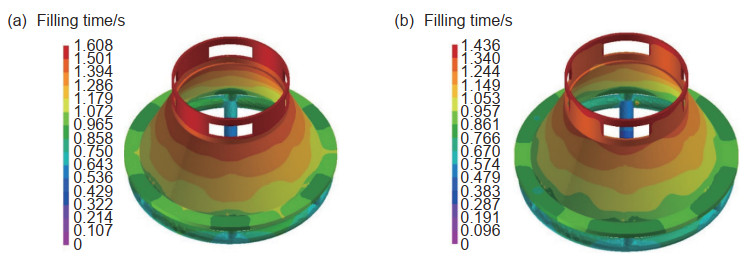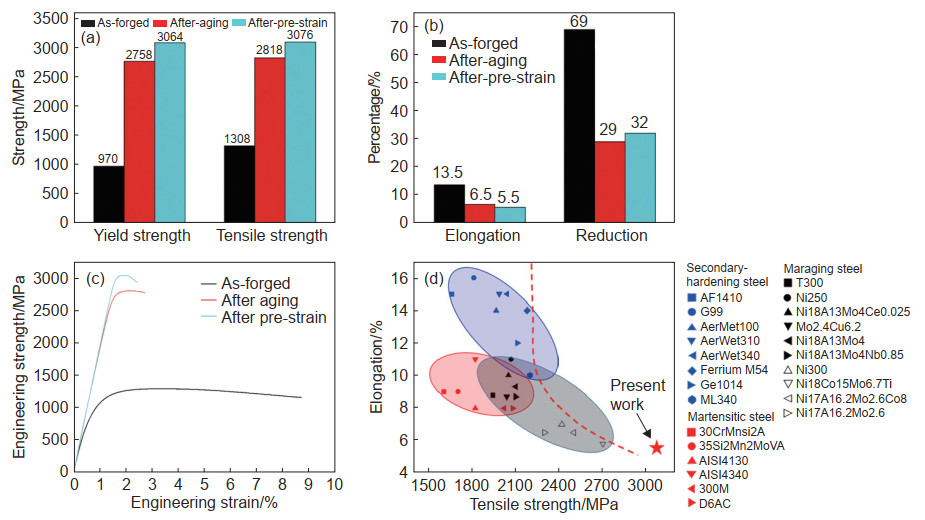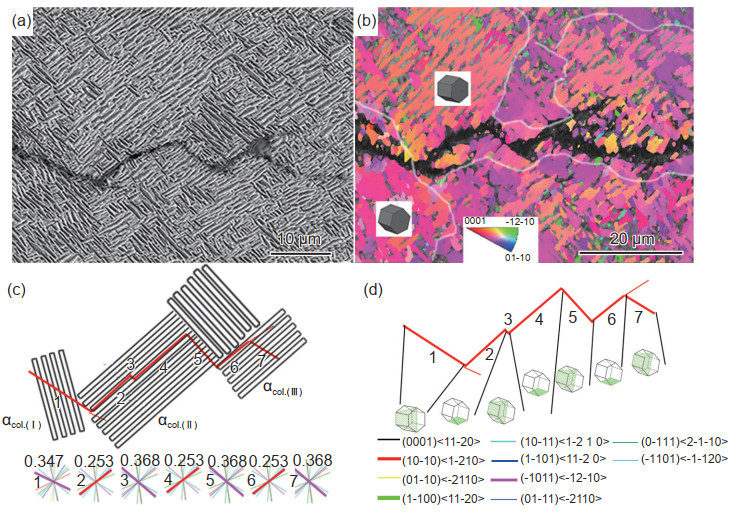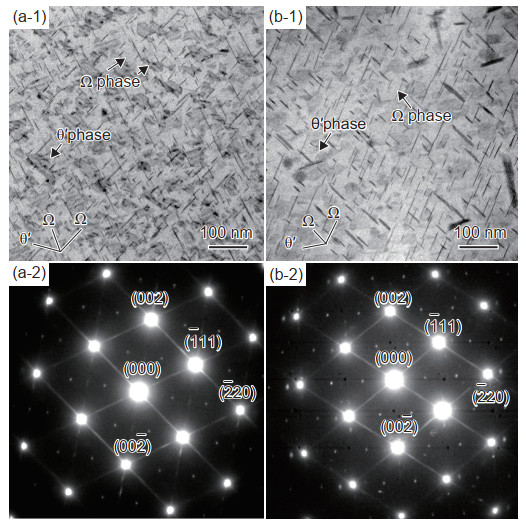Published: 01 April 2024
-
Select all|
-
Review2024, 44(2): 1-12. https://doi.org/10.11868/j.issn.1005-5053.2024.000050
Advanced materials technology is the forerunner in the development of high-tech aerospace equipment and the key foundational technology supporting the modern industry. It has penetrated into all aspects of national defense construction, national economy and social life, and has become a technological highland and national defense focus that countries all around the world are competing to develop. This article focuses on analyzing the current technological status and development trend of the advanced structural materials in the aerospace field, elaborating on the aspects of high-performance polymer and their composites, high-temperature and special metal structural materials, lightweight high-strength metals and their composites, and advanced structural ceramics and their composites. The analysis results show that the current development and production of aerospace structural materials in China still face various difficulties, such as too much follow-up research and imitation, lack of independent innovation, severe technological blockade, and technical bottlenecks need to be broken. Meanwhile, the prospects for future research and development are proposed, and the significance of establishing the complete technology system of production-learning-research-application is highlighted.
-
Review2024, 44(2): 13-30. https://doi.org/10.11868/j.issn.1005-5053.2024.000028
With the proposal of the "dual carbon”goals, using hydrogen as zero-carbon alternative fuel has become an important trend of the aviation industry in the future. In recent years, the hydrogen-fueled aero-engines have garnered significant attention. Superalloys are the most widely used materials in the hot section components of gas turbine engines. The purpose of this review is to provide reference for the research and development of superalloys for hydrogen-fueled aero-engines future use by understanding the effects of hydrogen-related environment on superalloys currently across various fields. Internal/external hydrogen environments, hydrogen permeation(charging)methods, measurement of hydrogen concentration/distribution or stable existence temperature, the influence of hydrogen on tensile strength, the impact of hydrogen on creep/stress rupture and fatigue properties, and the fracture mechanism of hydrogen embrittlement are described. The degradation factors of mechanical properties of superalloys with different composition, manufacturing process, original microstructure, alloying degree and different application fields under hydrogen-related environment are summarized. In general, mechanical properties tests in the external hydrogen environment exhibit more significant hydrogen-assisted mechanical degradations than that in internal hydrogen environments. Superalloys with higher alloying degree exhibit more pronounced hydrogen embrittlement, while the tendency of properties decrease(creep/rupture, fatigue and tensile)in hydrogen at elevated temperature is much less than that at room temperature. The prospects for the mechanical performance evaluation of current superalloys in hydrogen-related environments for hydrogen-fueled gas turbine and the development of new alloys suitable for hydrogen environments are provided. Hydrogen-fueled gas turbine aero-engines may encounter cryogenic temperature hydrogen environment for liquid hydrogen storage, hydrogen environment for cooling, high-temperature/high-pressure hydrogen environment for gas compression, and the impact of combustion products–water vapor(humid)at elevated temperature. Diffusion or permeation of hydrogen in superalloys, the embrittlement and corrosion of alloys in high-pressure hydrogen environments, oxidation and corrosion behavior in high-temperature humid environments, as well as the degradation and protection mechanism for alloys and coatings in the aforementioned multiple coupling environments shall be concerned. It is necessary to establish hydrogen combustion environment experimental facility that closely simulates service conditions to conduct research on the impact of hydrogen-related environment on superalloys and their components. It is also essential to establish a mechanical performance database and standards for currently used key materials in hot section components such as turbine blades and disks for hydrogen related environments, and properly develop new high-temperature structural materials suitable for hydrogen combustion conditions, which will provide support for the application of hydrogen fueled gas turbine aero-engines.
-
Review2024, 44(2): 31-44. https://doi.org/10.11868/j.issn.1005-5053.2023.000231
Superalloys are predominantly employed to crucial aviation hot-end components such as turbine rear casings, diffusers, and pre-swirl nozzles. The investment casting technology supersedes “casting + welding” forming approaches, which reduces the number of parts and processing procedures, offers improved reliability and mass reduction. Therefore, investment casting is a pivotal technology for aviation component manufacturing. However, the casting of complex thin-walled components encounters challenges with dimensional accuracy, impacting engine aerodynamic performance and assembly precision, which has become a bottleneck problem restricting the manufacturing quality of key structural components of aero-engines in China for a long time. This article reviews the current advancement in the dimensional accuracy control for superalloy investment castings at home and abroad. A forward-looking analysis and discussion on development trends are conducted, particularly focusing on digital and intelligent technologies. There is an urgent need to build a digital twin platform for investment casting in the future and to develop more advanced accurate, quantitative and intelligent prediction methods for dimensional deformation and die profile design theory.
-
Review2024, 44(2): 45-59. https://doi.org/10.11868/j.issn.1005-5053.2023.000178
The current research status of refractory high-entropy alloys(RHEAs) is reviewed, the composition design of RHEAs is described, and the effects of metal elements and non-metal elements on the structure and properties of RHEAs are summarized. In addition, the microstructure and mechanical properties of RHEAs under different preparation methods are described, and the strengthening mechanism of RHEAs matrix composites is discussed. The future development of RHEAs is prospected, and the following suggestions are put forward for its future research direction: enhancing of RHEAs by multiphase synergistic effects through the interface design between different phases; designing and optimizing the composition of RHEAs to develop RHEAs that are easy to process at room temperature; quickly screening the composition and microstructure of RHEAs by combining with high-throughput calculation methods; regulating and controlling the microstructure and structure of RHEAs by additive manufacturing technology; carrying out the configuration design of RHEAs matrix composites to balance the strength and plasticity of RHEAs matrix composites.
-
Review2024, 44(2): 60-71. https://doi.org/10.11868/j.issn.1005-5053.2023.000171
Ultra-high strength aluminum alloy has achieved extensive application in the nuclear, aerospace, and aviation industries because of its high specific strength and low density. The fifth generation of ultra-high strength aluminum alloy has been produced, and in comparison to the fourth generation’s 600 MPa level, its ultimate strength has been consistently redefined and increased from 650-700 MPa to 750 MPa or even 800 MPa. This paper reviews the history of the research on aluminum alloys with ultra-high strengths and introduces the current state of development both domestically and internationally. The key issues and recent research development are further explored, including computer simulation, thermal deformation, heat treatment, homogenization, melting, and casting, as well as composition design. Finally, combined with the development needs of future equipment and domestic technology status, it is pointed out that in-depth study of basic theory to solve the problem of comprehensive performance matching, the promotion and application of special materials in specific application scenarios are the development trend and important direction of ultra-high strength aluminum alloy.
-
Review2024, 44(2): 72-86. https://doi.org/10.11868/j.issn.1005-5053.2023.000218
With the rapid development of low-temperature fields such as deep space exploration, polar scientific research, low-temperature storage and transportation, the service conditions for low-temperature structural components are becoming increasingly stringent. Therefore, low-temperature materials have gradually become a research hotspot in the world. This article mainly summarizes the low-temperature performance and related mechanisms of common structural materials such as low-temperature steel, aluminum alloy, titanium alloy, aluminum matrix composites and resin matrix composites. The effects of different crystal structures, alloy types, alloying elements and other factors on the mechanical properties of structural materials such as low temperature strength, plasticity and toughness, and the mechanism of low temperature deformation, strengthening and toughening are concluded. The application and prospect of different grades of low-temperature structural materials in different fields at home and abroad are also briefly introduced. The future research prospect of low-temperature materials is put forward.
-
Review2024, 44(2): 87-103. https://doi.org/10.11868/j.issn.1005-5053.2023.000205
With the improvement of thrust-to-weight ratio and other properties of future aero-engine, the high temperature mechanical property and structural stability of titanium alloy components are required. The limitation of traditional experiments in time and space scale has become increasingly prominent, and it is difficult to deeply study the microscopic transient phenomena and mechanisms. Moreover, the molecular dynamics(MD)calculation method takes the atomic/molecular model as the calculation object, on the basis of Newton classical mechanics and empirical parameters, the calculation efficiency is greatly improved compared with the quantum calculation method. Therefore, MD has become an important method to optimize the process parameters and calculate the microstructure properties of aero-engine titanium alloy. Based on an overview of the basic principle of MD computing space and time scale advantages, this paper reviews the relevant domestic and foreign achievements in the study of molding, microstructure characterization and performance testing of aero-engine titanium alloys by MD method in recent years, as well as representative conclusions that contribute to the improvement of high temperature resistance of aero-engine titanium alloys. Finally, the future prospect is discussed based on the demand for MD computing technology for aircraft engine titanium alloys, thus pointing out the challenges faced on the following aspects, including high-throughput composition design based on MD computing method, training molecular force fields for mature titanium alloy systems, and introducing the new ReaxFF(Reactive Force Field)into the study of combustion mechanisms.
-
Review2024, 44(2): 104-116. https://doi.org/10.11868/j.issn.1005-5053.2023.000042
Propeller propulsion technology plays an important role in aviation field. Composite materials have the characteristics of high specific strength, high specific modulus, high damping, designability and so on. The use of composite material propeller blades can further improve the performance of propeller in terms of mass reduction efficiency, propulsion efficiency, corrosion resistance, noise reduction. Composite material propeller blades have become the general trend. Based on aircraft propeller blades and rotor blades, this paper aims to perform a brief review of the research achievements of aviation composite propeller blades at home and abroad, classifies and expounds the material systems, structural design and molding processes of aviation propellers. The key technical problems and the simulation research on manufacturing process of propeller at home and abroad are summarized. Finally, the future development direction of domestic composite propellers from the aspects of improving the material system, optimizing the structure design, deepening the process research and strengthening the engineering application of numerical simulation technology are concluded.
-
Review2024, 44(2): 117-124. https://doi.org/10.11868/j.issn.1005-5053.2023.000215
Heterocyclic aramid refers to a type of para-aramid containing aromatic heterocycles(usually benzimidazole units) in the main chain, which has excellent properties of lightweight, high strength and modulus, high thermal resistance and good solvent resistance. Compared to the typical aramid fiber Ⅱ, heterocyclic aramid exhibits superior mechanical properties and has been practically applied in the fields such as aerospace and bulletproof protection in China. However, similar to other organic fibers, the composite performance of heterocyclic aramids with resins is relatively low due to their inert surface, which limits their application in the field of advanced composite materials. This article from two aspects of surface modification and structural design, the design ideas, technical means and research results to enhance the composite performance of heterocyclic aramids in recent years are summarized, and the development trend of its application in the field of advanced composite materials is forecast, so as to provide assistance and reference for the interface design and improvement of interfacial adhesion of organic fibers.
-
Research Paper2024, 44(2): 125-132. https://doi.org/10.11868/j.issn.1005-5053.2023.000203
Additive manufacturing provides a new way to develop high-performance superalloys and components. A γ′- strengthened CoNi-base superalloy suitable for additive manufacturing was developed, and a crack-free block material was prepared by optimizing the parameters of electron beam melting(EBM) technology. The experimental results show that the lowest porosity of the alloy is about 0.14% when the scanning speed is 2000 mm/s. The microstructures of the as-printed CoNi-base alloy are columnar grains growing along the <001> direction, the average grain width is about 235 μm, and the volume fraction of γ′ phase is about 30%. After hot isostatic pressing and solution aging treatment, the porosity of the alloy is further reduced to about 0.09% with unobvious change of columnar grains. The average size of γ′ phases is about (70±18)nm with the volume fraction of about (32±3.6)%. The results of room temperature tensile tests show that the additive manufactured γʹ-strengthened CoNi-base superalloy exhibits excellent strength and ductility, showing a good potential of industrial application.
-
Research Paper2024, 44(2): 133-142. https://doi.org/10.11868/j.issn.1005-5053.2023.000192
The high temperature deformation behavior of vacuum powder forging FGH95 alloy was studied by Gleeble-3800 thermal simulation testing machine. The hot compression test was carried out at the deformation temperature of 1090-1170 ℃ and the strain rate of 0.01-10 s−1. The flow stress-strain curves under the corresponding conditions were obtained. The effects of deformation conditions on the microstructure evolution of vacuum powder forging FGH95 alloy were analyzed by EBSD. After considering the influence of temperature, strain rate and strain on the flow behavior of the alloy, the Arrhenius equation was selected to establish the constitutive model of vacuum powder forging FGH95 alloy, and the parameters of vacuum powder forging FGH95 alloy were obtained. The relationship between material parameters and strain was fitted and the obtained constitutive equation was verified.The results show that the flow stress of FGH95 alloy prepared by vacuum powder forging process decreases with the increase of temperature and increases with the increase of strain rate. The size of recrystallized grains in the deformed microstructure decreases with the increase of temperature and increases with the decrease of strain rate. The error between the predicted value and the experimental value of the flow stress of the vacuum powder forging FGH95 alloy is 6.33%, and the predicted value is in good agreement with the experimental value.
-
Research Paper2024, 44(2): 143-150. https://doi.org/10.11868/j.issn.1005-5053.2021.000190
In view of the shortage of conventional design methods of pressure curve in the anti-gravity precision casting and taking the structural characteristics of the casting with variable cross-sections into account, automatic calculation of cross-sectional areas was implemented for the casting and gating system by the secondary development of CAD software, and quantitatively describing the variable feature of cross-sections of casting was realized. Based on Bernoulli and flow conservation equations, the relationship between the filling pressure and the rising speed of metal liquid level was deduced. A new design method of pressure curve based on the automatic calculation of cross-sectional areas of the casting was proposed. The simulation results of anti-gravity casting for nickel-based superalloy demonstrate that, compared with the pressure curve of the conventional design method, the new curve can reduce the peak value of filling speed from 0.611 m/s to 0.439 m/s at the minimum cross-sectional area, the falling range of which is 28.15%. It meant that the new method can effectively avoid the shock and splash of liquid metal, meanwhile, shorten the filling time, then the filling process is fast and stable. The hydraulic experiment and pouring experiment show that the new pressure curve has a smoother filling liquid level and can effectively avoid casting defects. Therefore, it proves the effectiveness of the new pressure curve design method and provides a basis for rational design of anti-gravity pressure curve.
-
Research Paper2024, 44(2): 151-158. https://doi.org/10.11868/j.issn.1005-5053.2023.000197
The miniaturization and lightweight development of aerospace systems have raised higher requirements for the strength and ductility of power shaft materials. In order to develop maraging steel with the strength exceeded 3 GPa, an experimental maraging steel with high contents of Co, Ni, and Mo elements was designed. Its chemical composition is 4Ni-15Co-9Mo-0.86Ti-0.35Al-Fe. Through the high-temperature and large-scale plastic deformation with forging ratio greater than 10, the grains were refined as much as possible. Combining with pre-stretching deformation and cryogenic treatment followed by aging treatment, the tensile strength of the experimental steel reached 3.076 GPa, with the elongation at break of 5.5%, exhibiting excellent strength and plasticity. The analysis and characterization of the microstructures indicated that the lath martensitic microstructure with high dislocation was formed in the experimental steel, and obtained extra fined grains with the average grain diameter of 0.47 μm. TEM and 3DAP results show that a large number of Ni3(Mo, Ti)precipitates is distributed in the matrix, with the average precipitate diameter of 6-7 nm. Precipitation strengthening, grain refinement strengthening and dislocation strengthening are the main strengthening mechanisms, which ensure an ultrahigh strength over 3 GPa of the experimental steel, while the extremely fine submicron grains also ensure the good ductility of the steel.
-
Research Paper2024, 44(2): 159-168. https://doi.org/10.11868/j.issn.1005-5053.2023.000175
The precipitation behavior of secondary α phase and mechanical properties of high strength TB9 titanium alloy were investigated during single aging and duplex aging. The alloy phase constitution was analyzed by XRD, and the microstructure was observed by optical microscopy and scanning electron microscopy. The evolution characteristics of the microstructure with aging temperature were mainly analyzed. The room temperature tensile properties and fracture toughness were tested. The research results indicate that during single aging, secondary α phase exhibits serrated and layered precipitation. With increasing aging temperature, the size of α phase increases, and the content of layered α phase increases. The strength at 430 ℃ aging is lower and the plasticity is higher. The strength at 470 ℃ aging is the highest. With increasing aging temperature, the strength first increases and then maintains at the similar level. During duplex aging, most of secondary α phases precipitate in a serrated shape within the grains. With increasing aging temperature, the size of α phase increases, the tensile strength first increases and then decreases, reaching a maximum of 1542 MPa. The tensile strength of duplex aging is significantly higher than that of single aging, which is mainly due to the combined strengthening effect of second phases near grain boundaries and intragranular α phases with serrated shape.
-
Research Paper2024, 44(2): 169-175. https://doi.org/10.11868/j.issn.1005-5053.2023.000196
Flaw tolerance performance of TC4 alloy was investigated for helicopter transmission systems design. The impact pit flaws and scratch flaws were investigated by fatigue specimens with same flaw depth for flaw tolerance design, and high-cycle fatigue S-N curve tests were conducted. The results show that both scratch flaws and impact pit flaws significantly reduce the fatigue limit of the TC4 titanium alloy. The scratch flaw has a higher flaw influence factor(Kflaw) of 2.29 compared to the impact pit flaw’s Kflaw value of 1.75 under the same flaw depth conditions. Fracture surface analysis provided laws of the fatigue crack initiation and propagation associated with these flaws. Scratch flaws mainly exhibit multiple sources, with crack initiated at the root of the scratch, while the characteristics of fatigue crack initiation for impact pit flaws vary with the applied stress. Multiple sources are observed under high stress lever, with crack initiated on the surface of the pit, while under low stress, the crack initiates at a subsurface of the pit.
-
Research Paper2024, 44(2): 176-183. https://doi.org/10.11868/j.issn.1005-5053.2023.000154
High strength Ti-5Al-3Mo-3V-2Zr-2Cr-1Nb-1Fe(Ti-5321) alloy is a new type of high strength tolerance titanium alloy designed and developed to meet the demand of high performance titanium alloy for new generation aircraft in China. Ti-5321 alloy with equiaxed microstructure(EM), basket-weave microstructure(BW) and fine basket-weave microstructure(F-BW)was obtained by forging and heat treatment, and the tensile properties and fatigue crack growth behavior were studied. Fatigue crack propagation mechanisms in Paris and unstable propagation regimes were revealed by analyzing the microstructures and fracture morphology using optical microscopy (OM) and scanning electron microscopy (SEM). The results show that the samples with EM, BW and F-BW exhibit the excellent fatigue crack propagation resistance with the tensile strength of 1200 MPa. The sample with F-BW presents the highest fatigue crack propagation resistance in Paris and rapid growth regimes, while the sample with EM presents the lowest fatigue crack propagation resistance. In F-BW, the crack mainly propagates through and along α phase. Crack tends to propagate across colony oriented for (
$ \bar{1} 011$ )<$ {1}2\bar10 $ > pyramidal slip and propagates along colony oriented for ($10 \bar{1} 0$ )<$1 \bar{2} 10$ > prismatic planes. -
Research Paper2024, 44(2): 184-191. https://doi.org/10.11868/j.issn.1005-5053.2023.000174
The AlSi10Mg alloy samples were successfully prepared by laser powder bed fusion(LPBF). The effects of three kinds of heat treatment process, namely 130 ℃/4 h aging treatment, 236 ℃/10 h annealing treatment, and 540 ℃/1 h solid solution treatment on the microstructure of the AlSi10Mg samples were investigated. After heat treatment, the evolution of coefficient of thermal expansion(CTE) and thermal conductivity of the AlSi10Mg alloy in the temperature range from room temperature to 400 ℃ was examined. The results show that spherical Si particles are precipitated within the aluminum matrix, while the complete network-like eutectic silicon structure is retained after aging treatment. After annealing, the network-like silicon structure is disappeared completely, and spherical Si particles are uniformly distributed within the matrix. After solution treatment, large blocky Si particles with the sizes from 1 μm to 3 μm appear. The thermal properties of the AlSi10Mg alloy have been improved significantly after heat treatment compared to the as-printed state. In particular, the CTE of alloy subjected to annealing is 1.64×10−5 ℃−1 to 2.1×10−5 ℃−1 within the temperature range from room temperature to 400 ℃, the average thermal conductivity is 179.6 W·m−1·K−1, the performance is superior to ageing and solution treatments.
-
Research Paper2024, 44(2): 192-200. https://doi.org/10.11868/j.issn.1005-5053.2023.000136
The room temperature tensile properties and elevated temperature tensile properties of peak aged Al-Cu-Mg-Ag hub forgings after different heat exposure temperatures and heat exposure time were tested, and the thermal stabilities of the forgings at different temperatures were compared and analyzed. The results show that Al-Cu-Mg-Ag forgings exhibit good thermal stability. After exposure at 150 ℃ for 1 to 100 h, there were no significant changes in room temperature tensile properties and elevated temperature tensile properties. Short time heat exposure at 150-200 ℃ for 1 h does not reduce the overall performance, but the strength of Al-Cu-Mg-Ag forgings decreases with the increase of heat exposure temperature and the extension of heat exposure time. After 100 h of exposure at 200 ℃ and 250 ℃, the room temperature yield strength remains 61.1% and 37.2 %, and the room temperature tensile strength remains 77.8% and 60.8%, the elevated temperature yield strength remains 61.6% and 42.8%, and the elevated temperature tensile strength remains 67.5% and 47.6%, respectively. The main precipitates of Al-Cu-Mg-Ag forgings are Ω phase and θ′ phase. Under the experimental conditions of Kt=1 and R=0.1, the room temperature fatigue limit after 200 ℃/10 h heat exposure is 278 MPa, which is 10.6% lower than the fatigue limit of 311 MPa before heat exposure.



